Contents

Introduction

WHEN I STARTED FOLLOWING THE LOW-CARB lifestyle a few years ago, my biggest challenge by far was giving up bread. Up until then, bread and grain-based foods had been the foundation of my daily dietlooking back, I realize I was probably addicted to the stuff. While I didnt miss pasta at all, doing away with sandwiches or slices of crispbread layered with butter and cheese was another thing altogether. At first I thought I could get away with simply eating thinner pieces of crispbread. However, when I began to understand the havoc that gluten was wreaking on my health, I decided to give up gluten-laden foods entirely, including those beloved slices of crispbread I still occasionally treated myself to. Many of us deal with stress on a daily basis.
There doesnt seem to be enough hours in the day to get everything done, including cooking a nutritious and satisfying breakfast, when so much else competes for our attention. Thats why in many ways the humble sandwich is a perfect solutionand because it can be eaten on the run. What about brown-bagging lunch? Again, a sandwich is a great option for eating at the officebut then again, who has the time to fix it before rushing out the door in the morning? This may be a slight exaggeration, but its still uncomfortably close to reality for many of us with busy schedules. This is where my nutritious yet low-carb bread recipes come into play. In Sweden we call a loaf of bread matbrd, which can be translated into English as food bread. The name is fitting; in this book the sandwich is elevated to its rightful status as proper food, because all of my breads can be considered food in their own right, as opposed to mere vessels for more wholesome meals.
They are nutritional powerhouses. Who could ask for more? Ive stretched my imagination and experimented with herbs and spices in order to include as many different styles and varieties of bread as possible in this book. Youll find many recipes for loaves and rolls, both white and dark, as well as crispbreads, pizza, empanadas, and lots more! Wishing you all a life filled with joy and good health, Mariann  Low-Carb High-Fat Breads Bread baked according to Low-Carb High-Fat guidelines differs from traditionally baked bread in that it contains very few carbohydrates and is often combined with an elevated amount of fat. Further significant differences from grain-based bread are the absence of gluten and the inclusion of a large amount of eggs. Eggs contain high levels of nutritiously beneficial protein, vitamins, minerals, and micronutrients; when incorporated into dough, they help to turn out bread that is both filling and deeply satisfying. We dont call eggs a superfood for nothing.
Low-Carb High-Fat Breads Bread baked according to Low-Carb High-Fat guidelines differs from traditionally baked bread in that it contains very few carbohydrates and is often combined with an elevated amount of fat. Further significant differences from grain-based bread are the absence of gluten and the inclusion of a large amount of eggs. Eggs contain high levels of nutritiously beneficial protein, vitamins, minerals, and micronutrients; when incorporated into dough, they help to turn out bread that is both filling and deeply satisfying. We dont call eggs a superfood for nothing.
Even LCHF bread doesnt usually contain enough fat by itself, so we help it conform closer to the LCHF formula by spreading our sandwiches with delicious grass-fed butter and by adding slices of aged cheese, ham, sliced deli sausage, or other delicious fatty fillings. By doing so, we get an LCHF sandwich that is food through and through. Furthermore, since LCHF bread is naturally gluten-free, its perfect for those who are gluten-intolerant, and its low-carb content makes it highly suitable for diabetics. Breads Made with Grains In early civilizations, our ancestors didnt turn to grains for nutrition. People have inhabited the planet for millions of years, but have only been cultivating grains in Scandinavia for approximately four thousand years. This has been too short a time for our digestive tract to become adjusted to the daily ingestion of grains from our modern diet.
Starch All grains such as oats, wheat, rye, and corn contain glucose in the form of starch, which elevates blood sugar. Those of us who eat a low-carbohydrate diet should aim to keep our intake of starch as low as possible. Gluten Our commonly used grainswheat, rye, and cornalso contain gluten. Gluten is a vegetable protein that can irritate the lining of the small intestine and bring on gluten intolerance and celiac disease. Celiac disease, also known as celiac sprue, is an autoimmune disease that develops when the small intestine becomes hyper-sensitive to gluten. The intestinal villi (small fingerlike projections in the lining of the intestinal wall) deteriorate, which disrupts the uptake of nutrients from ingested food, and may cause large amounts of the protein in that food to leak into the body.
Celiac disease is often linked to other autoimmune disorders, such as type 1 diabetes and rheumatism. Many affected by celiac disease are unaware of their condition because they do not feel sick or suffer from stomachaches. If left untreated, however, celiac disease can lead to fatigue, anemia, infertility, and weight loss; it can also cause a variety of stomach ailments. Gluten intolerance manifests itself in such a wide array of symptoms that it can be challenging to pinpoint gluten as the source of trouble. It often brings on diarrhea, constipation, and gas, and can be painful. It can also exacerbate the severity of other allergies as well as chronic conditions such as asthma.
Gluten can damage the intestine to the point where the enzyme that breaks down lactose is lost. More and more people are diagnosed as lactose intolerant, which in some cases could be traced back to their gluten-damaged intestine reacting to lactose. These days, many grocery stores carry bread labeled Low Carb or LCHF. It is important to note, however, that much of this commercially manufactured bread contains gluten as a main ingredient. Worse, it might even include wheat flour. These breads may be low in carbohydrates, but are they healthy? Not in my worldmy world is gluten-free.
Baking Healthy Breads From a practical standpoint there is a huge advantage to baking low-carb bread: its quick! Theres no need to set aside time for the rising of the doughyou simply whisk the batter together, let it rest for a few minutes, and a short while later the dough is ready to form and bake. If the dough doesnt seem firm enough to the touch, add additional fiber husk or coconut flour. Start by adding half a tablespoon of fiber husk or one tablespoon of coconut flour to the batter, let the dough rest a minute, then check the consistency. Be sure to add only a little fiber at a time, because if you add too much the bread might end up too dry and crumbly. Be aware that some types of dough start out sticky on purpose so that the bread doesnt become too dense. Wet your palms with cold water to make the dough easier to handle.
If the finished product still doesnt seem airy enough, try decreasing the amount of flour when mixing the dough. If you want to bake the loaves in loaf pans, line a six-cup loaf pan with parchment paper and pour in the batter. Freestanding loaves baked on baking sheets will need more flour in the dough to make them easier to form and able to retain their shape while baking. I usually place the items on the middle shelf and use the convection function on my oven. However, this book uses temperatures for conventional ovens, so if you have a convection oven, simply decrease the given temperature by fifteen degrees Celsius. For Fahrenheit, reduce the temperature by twenty-five degrees and keep the time consistent.

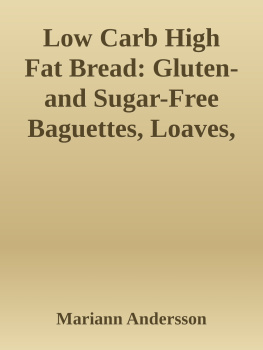
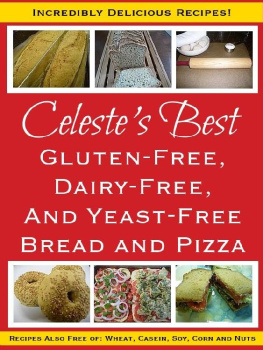


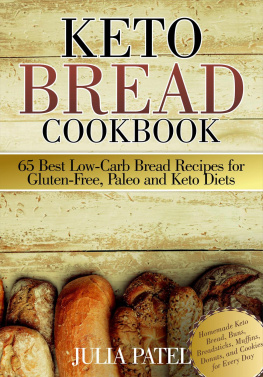
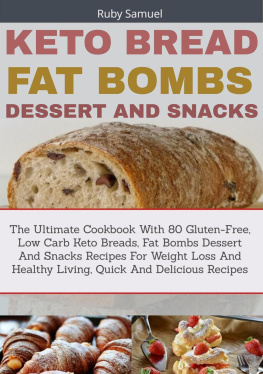



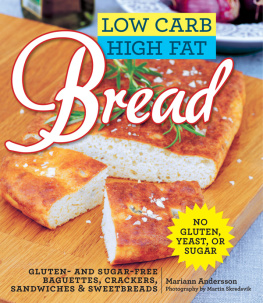
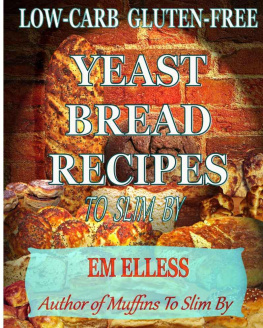
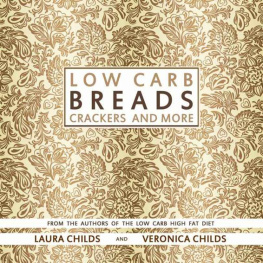


 Introduction
Introduction  WHEN I STARTED FOLLOWING THE LOW-CARB lifestyle a few years ago, my biggest challenge by far was giving up bread. Up until then, bread and grain-based foods had been the foundation of my daily dietlooking back, I realize I was probably addicted to the stuff. While I didnt miss pasta at all, doing away with sandwiches or slices of crispbread layered with butter and cheese was another thing altogether. At first I thought I could get away with simply eating thinner pieces of crispbread. However, when I began to understand the havoc that gluten was wreaking on my health, I decided to give up gluten-laden foods entirely, including those beloved slices of crispbread I still occasionally treated myself to. Many of us deal with stress on a daily basis.
WHEN I STARTED FOLLOWING THE LOW-CARB lifestyle a few years ago, my biggest challenge by far was giving up bread. Up until then, bread and grain-based foods had been the foundation of my daily dietlooking back, I realize I was probably addicted to the stuff. While I didnt miss pasta at all, doing away with sandwiches or slices of crispbread layered with butter and cheese was another thing altogether. At first I thought I could get away with simply eating thinner pieces of crispbread. However, when I began to understand the havoc that gluten was wreaking on my health, I decided to give up gluten-laden foods entirely, including those beloved slices of crispbread I still occasionally treated myself to. Many of us deal with stress on a daily basis.  Low-Carb High-Fat Breads Bread baked according to Low-Carb High-Fat guidelines differs from traditionally baked bread in that it contains very few carbohydrates and is often combined with an elevated amount of fat. Further significant differences from grain-based bread are the absence of gluten and the inclusion of a large amount of eggs. Eggs contain high levels of nutritiously beneficial protein, vitamins, minerals, and micronutrients; when incorporated into dough, they help to turn out bread that is both filling and deeply satisfying. We dont call eggs a superfood for nothing.
Low-Carb High-Fat Breads Bread baked according to Low-Carb High-Fat guidelines differs from traditionally baked bread in that it contains very few carbohydrates and is often combined with an elevated amount of fat. Further significant differences from grain-based bread are the absence of gluten and the inclusion of a large amount of eggs. Eggs contain high levels of nutritiously beneficial protein, vitamins, minerals, and micronutrients; when incorporated into dough, they help to turn out bread that is both filling and deeply satisfying. We dont call eggs a superfood for nothing.